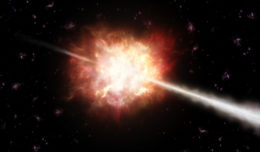There’s still a lot we don’t know about the internal structure and behavior of neutron stars, the compact remnants of giant, collapsed stars. Can the mergers of neutron stars with another type of exotic object, black holes, reveal important information?
Uncharted Remnants

Illustration of a short gamma-ray burst, which could be produced during the collision of a neutron star with a black hole. [ESO/A. Roquette]
A star’s internal properties are characterized by its “equation of state”. To better constrain the equation of state for neutron stars, we need accurate measurements of their masses and radii. But though we know that neutron stars are typically have the mass of a couple of Suns packed into a sphere of order 10 km in radius, it’s challenging to get precise enough radius measurements to constrain the equation of state for these dense, distant objects.
Can we do a better job of measuring neutron-star radii using future observations of merging neutron-star–black-hole binaries? A team of scientists led by Stefano Ascenzi (Tor Vergata University of Rome, INAF Rome Observatory, and Sapienza University of Rome, Italy) thinks the answer is yes — and in a new study, the team outlines how.
A Well-Marked Collision
It’s expected that the merger of a neutron star with a black hole would result in the destruction of the neutron star, the brief formation of a torus around the black hole as the neutron-star matter rains back down, and the rapid accretion of the torus.
This process would produce a pair of observable signals:
- a gravitational-wave chirp from the merger, visible to detectors like the Laser Interferometer Gravitational-wave Observatory (LIGO) and its European counterpart Virgo, and
- a short gamma-ray burst (GRB) caused by the accretion of the torus.

Example of how the various curves of mass vs. radius described by different neutron-star equations of state (colored curves) could be eliminated based on mass and radius measurements of a neutron star during a merger. In this test run, the authors’ injected neutron star properties are shown by the blue dot and the recovered properties are shown by the red dot. The red dashed lines show the 68% and 90% credible regions for the recovered properties — which, in this example, eliminate several of the possible equations of state. [Adapted from Ascenzi et al. 2019]
The combination of this information allows us to infer the radius of the neutron star in the initial binary. Ascenzi and collaborators show that this method would let us estimate a neutron star radius to within 20% accuracy for a gravitational-wave detection with a signal-to-noise ratio of 10. For comparison, the signal-to-noise ratio for GW 170817, the first observed binary neutron star merger, was more than 30.
Looking for a New Type of Merger
How lucky do we have to get to observe a neutron-star–black-hole merger simultaneously in gravitational waves and electromagnetic radiation? Theory predicts these joint detections will perhaps occur at rates of 0.1 to 10 per year with current technology, and future telescopes and gravitational-wave detectors should increase our odds.
Here’s hoping these spectacular explosions will reveal more about neutron-star interiors soon!
Citation
“Constraining the Neutron Star Radius with Joint Gravitational-wave and Short Gamma- Ray Burst Observations of Neutron Star–Black Hole Coalescing Binaries,” Stefano Ascenzi et al 2019 ApJ 877 94. doi:10.3847/1538-4357/ab1b15

1 Comment
Pingback: Daily Log (2019-08-06) - Study Astrophysics